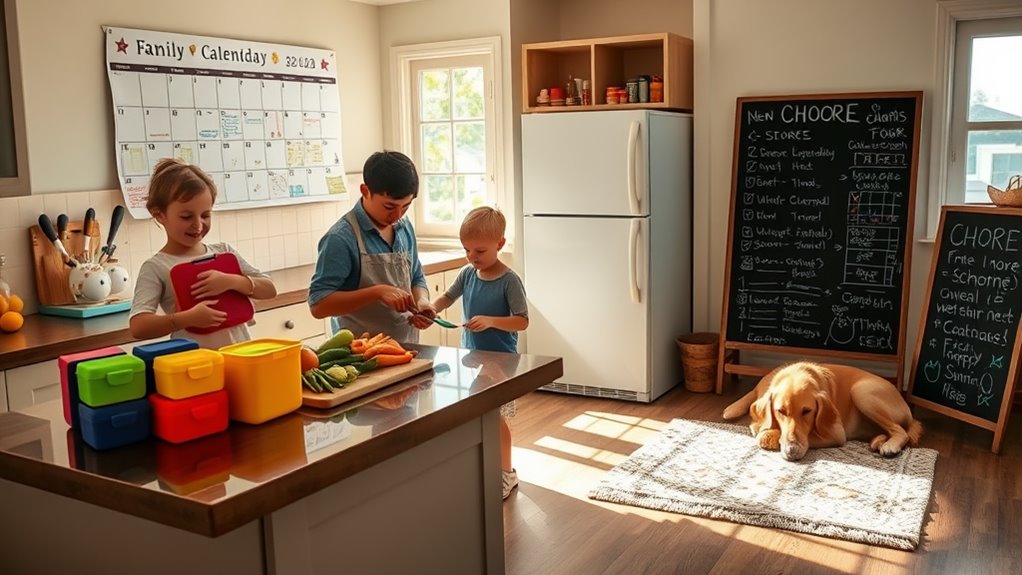Family Routines to Create a Happier Home!
To create a happier home, establishing routines is key. Start with daily check-ins; they boost communication and emotional support among family members. Meal times can also transform connections—planning and cooking together fosters collaboration. Don’t forget to schedule fun activities; game nights or outdoor adventures nurture joy and involvement. A family chore chart encourages teamwork and accountability, while tech-free evenings promote meaningful interactions. By implementing these routines, you’ll strengthen bonds and nurture happiness in your home. There’s so much more to explore about building these connections that can really enhance your family life, so keep going!
Key Takeaways
- Establish daily check-ins to foster open communication and emotional support among family members.
- Design intentional family meal times to enhance connections and encourage collaboration during cooking.
- Schedule fun family activities, like game nights or outdoor adventures, to strengthen bonds and create joyful memories.
- Create a family chore chart to promote accountability, teamwork, and a sense of ownership among all members.
- Implement tech-free evenings to encourage meaningful conversations and shared experiences without distractions.
Establishing Daily Check-Ins
In the hustle and bustle of daily life, it’s easy for family members to drift apart, even under the same roof. Establishing daily check-ins can help counteract this tendency, fostering open communication and emotional support among your loved ones.
These brief, intentional conversations allow everyone to share their thoughts, feelings, and experiences, reinforcing that you’re all in this together.
Set aside a specific time each day, whether it’s during breakfast, after school, or before bed, to connect with each other.
During these check-ins, encourage each family member to express what’s on their mind. They might share triumphs, struggles, or even just how their day went.
This practice not only cultivates a sense of belonging but also nurtures empathy within the family.
Designing Family Meal Times
Creating inviting family meal times can transform the way your household connects. When you engage in meal planning together, you’re not just deciding what to eat; you’re fostering collaboration and communication.
Sit down as a family and brainstorm meals everyone would enjoy. This approach encourages participation and values each person’s preferences, making everyone feel included.
Cooking together can also deepen bonds. Choose a night where everyone contributes to the meal preparation. Whether it’s chopping veggies, stirring sauces, or setting the table, these shared tasks create a sense of unity and accomplishment.
As you cook, take the opportunity to share stories and laughter, turning the kitchen into a space of warmth and connection.
Don’t forget to establish a routine around your meals. Set a regular dinner time where everyone can gather without distractions. This predictability not only builds anticipation but also reinforces the importance of family togetherness.
Scheduling Fun Family Activities
Life can often get busy, making it easy to overlook the joy of spending quality time together as a family. Scheduling fun family activities is vital to nurture those connections. By intentionally planning time for family game nights and outdoor adventures, you create lasting memories and strengthen your bond.
Here’s a simple table to help you brainstorm potential activities:
| Activity Type | Example Activity |
|---|---|
| Family Game Nights | Board game tournament |
| Outdoor Adventures | Hiking at a local park |
| Creative Projects | Family art night |
| Movie Nights | Themed movie marathon |
Choose activities that resonate with everyone in the family. Rotate who picks the activity each week to guarantee everyone feels involved. Remember, the goal isn’t just to have fun but to engage in meaningful interactions.
Scheduling these activities not only adds excitement to your family routine but also provides a sense of stability and anticipation. By making a commitment to share these experiences, you’re setting the stage for a happier home, where laughter and joy flourish. Embrace this intentionality, and watch your family’s connections grow stronger.
Creating a Family Chore Chart
Many families find that establishing a chore chart can transform daily tasks into a more enjoyable experience. By creating a visual representation of responsibilities, you not only foster accountability but also encourage teamwork.
Start by using chore chart templates to simplify the process. These templates can be tailored to fit your family’s unique needs and schedules, making it easier for everyone to see what’s expected.
Involve your children in the creation of the chart. Discuss age-appropriate chores and allow them to express their preferences. This inclusion builds a sense of ownership and pride in contributing to the household.
Consider implementing a rewards system to motivate your family. For instance, you might offer points for completed tasks that can be redeemed for a fun family outing or extra screen time. This not only makes chores feel less burdensome but also reinforces positive behavior.
Regularly review and adjust the chore chart to guarantee it remains relevant. Celebrate achievements, big or small, to maintain enthusiasm.
Implementing Tech-Free Evenings
After establishing a chore chart, you might find that the time spent together as a family is just as important as the tasks you tackle. Implementing tech-free evenings can be a game-changer for evening bonding. By setting aside screens, you create a space for meaningful conversations and shared activities that strengthen your family’s connection.
The screen-free benefits are profound. You’ll notice reduced distractions, allowing everyone to engage fully with one another. Use this time for board games, cooking together, or simply sharing stories about your day. These activities not only nurture relationships but can also spark creativity and laughter.
It’s essential to set clear boundaries. Start by designating a specific evening each week to unplug. Encourage everyone to participate by suggesting activities they enjoy. This practice will help foster an environment of togetherness and open communication.
As you embrace tech-free evenings, you’ll likely discover a renewed appreciation for each other. The memories you create during this time can help solidify your family’s bond, making your home a happier place.
Frequently Asked Questions
How Can I Involve Younger Children in Family Routines?
To involve younger children in family routines, encourage playful participation by assigning age-appropriate tasks. Make it fun and engaging; let them feel valued. This fosters responsibility and strengthens family bonds while teaching essential skills.
What if Family Members Resist Participating in Routines?
When resistance feels like a storm cloud, try using resistance strategies. Engage hearts with positive reinforcement; celebrate small wins. It’s a journey, not a race, so be patient and nurturing to cultivate willingness.
How Do I Track Progress on Family Routines Effectively?
To track progress effectively, create a routine calendar that everyone can access. Mark achievements, note challenges, and celebrate small wins together. This not only helps you stay organized but also fosters accountability and motivation within the family.
Can Routines Be Adjusted for Busy Schedules?
Absolutely, routines can be adjusted for busy schedules! By embracing flexible scheduling and refining your time management skills, you can create a balanced approach that accommodates life’s demands while still fostering consistency and connection.
What Are the Benefits of Routines Beyond Family Bonding?
Routines bring numerous benefits beyond bonding. They can greatly reduce stress, providing a sense of predictability. You’ll also find improved communication, as everyone knows their roles, fostering understanding and cooperation in daily interactions.




